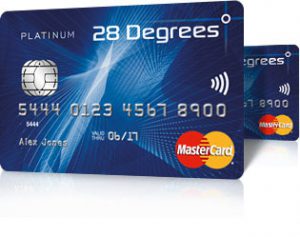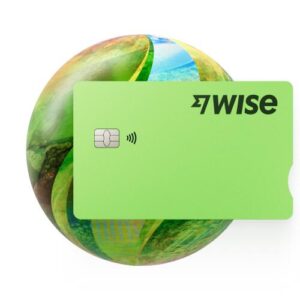Best Ways to Take Money to Canada in 2026
If you’re planning a trip to Canada - or even if you’re thinking of moving there for work or study - you’ll need to figure out how to pay for things in Canadian dollars while you’re there.
This guide runs through 4 possible ways to take money to Canada so you can find the one that suits your specific needs best. We’ll cover the benefits and drawbacks of each payment method, to help you avoid unnecessary fees and pick the right way for you.
Best ways to take money to Canada
In this guide we’ll walk through 4 of the most practical and popular ways to take money to Canada, including our top picks for providers to look at, pros and cons. Here are the common ways to pay overseas that we’ll investigate:
Prepaid travel cards to use in Canada
Ideal for: holding a balance in CAD alongside AUD and other currencies, for convenient spending in Canada and elsewhere
You can get a prepaid travel card from a specialist service, which comes with a linked digital multi-currency account you can top up in AUD, before switching over to Canadian dollars for your trip. Some cards also let you hold your balance in AUD and just calculate the conversion at the point of payment instead, which means you have the option of switching and setting your spending budget in advance, or just converting as you go.
Most prepaid travel cards support a selection of currencies for holding and exchange. The most important thing to look out for when choosing is the exchange rates and fees applied. Pick a card with no inactivity fee and no ongoing charges, which supports a large number of different currencies so you can use it on future foreign trips, too.
Learn more about our picks for the 6 best prepaid cards.
Wise - our pick for prepaid travel card
With this card:
- Hold and exchange 40+ currencies in your linked Wise account
- No annual or monthly fees to pay, and no minimum balance requirement
- Currency exchange uses the mid-market rate with no markup
- Some free ATM withdrawals available every month
- Virtual and physical cards available
| Wise card pros | Wise card cons |
|---|---|
| ✅ Currency exchange uses the mid-market rate
✅ No foreign transaction fees apply ✅ Free to hold and spend 40+ currencies ✅ Receive payments to your Wise account in a selection of global currencies ✅ No minimum balance or ongoing fees |
❌ 10 AUD fee to get a card in the first place
❌ Free ATM withdrawals are limits to 2 per month, to the value of 350 AUD. Fees of 2% + 1.5 AUD after that ❌ Express delivery fees if you want to get your card as soon as possible |
Pros and cons of taking money to Canada with a prepaid travel card
Pros:
- Canadian dollars are supported by most prepaid travel cards available in Australia
- Convenient for both spending and cash withdrawals
- Secure as not linked to your everyday AUD account
- Many cards have no minimum balance amount and no ongoing fees to pay
- Currency exchange may have better rates than a bank will offer
Cons:
- Inactivity fees and exchange rate markups may apply depending on the card you select
- ATM fees may apply, depending on the card you pick
- Some cards charge a fee if you spend in an unsupported currency, or if you spend a currency you don’t hold in your account already
Travel debit cards to use in Canada
Ideal for: easy ways to spend in Canada, with no interest or penalty fees - and often lots of travel perks like airport lounge access or insurance
You’ll find travel debit cards available to order online from specialist services, and from a handful of popular banks operating in Australia.
If you pick a card from a specialist provider like Revolut, you’ll also get a linked multi-currency account which you can use to hold, spend and withdraw in a broad selection of foreign currencies conveniently. Many cards also offer better exchange rates than a bank usually will, with extras like some fee free ATM withdrawals and complimentary travel insurance.
Cards from specialist services aren’t connected to your everyday AUD account, which adds peace of mind. In practice this means that even if the travel card was stolen, your normal account and card is secure and thieves have no access to your main bank account.
We’ll go into more detail about our top pick for a travel debit card - Revolut - next, and you can also read more about the best travel debit cards in Australia here.
Revolut - our pick for travel debit card
With this card:
- Hold and exchange 25+ currencies
- Choose the account plan that suits your needs and spending, including some with no monthly fees
- Some no- fee ATM withdrawals and currency exchange with the mid-market rate, based on the account tier you choose
- Extra perks like accounts for under 18s, plus cash back on card spending for top tier account holders
- Travel benefits offered for some account plans
| Revolut card pros | Revolut card cons |
|---|---|
| ✅ Hold and exchange 25+ currencies
✅ Choose from different account tiers to suit different customer needs ✅ Get some no fee ATM withdrawals every month, depending on the plan you pick ✅ Get some currency exchange every month which uses the mid-market rate - limits vary by account plan ✅ No card order fee |
❌ Ongoing fees apply for some account tiers
❌ Out of hours fees push up currency exchange costs on the weekend ❌ ATM fees of 2% apply once you exhaust your no fee withdrawals |
Pros and cons of taking money to Canada with a travel debit card
Pros:
- Convenient for spending and withdrawals in Canadian dollars - accounts often support dozens of other currencies too
- Use ATMs when you need to, to avoid carrying a lot of cash at any one time
- No interest or penalty fees - just top up the amount you want to spend and you’re done
- Not connected to your main AUD account, adding a layer of security when you’re overseas
Cons:
- Not a credit card - so you’ll need to fund your account upfront
- Some transaction fees usually apply
- Some cards have monthly fees to pay to get full feature access
Taking cash in Canada
Ideal for: small purchases, tipping, taking a taxi - and as a back up plan in case your card can’t be used
As with many countries, the Covid pandemic dramatically increased the number of people preferring to use contactless payment methods over cash in Canada. In fact, 2021 research shows that only about 10% of all transactions in Canada used cash.
Using a card to pay for things at home and abroad is usually the most popular option for most people. However, there are still some situations when you simply can’t use your card, especially for very low value purchases or when shopping in markets. You’ll likely also want some Canadian dollars in cash for tipping, too.
All in all, carrying some CAD cash is a smart move. You’ll avoid embarrassment when a card payment is just not possible, and you’ll know you’ve always got a back up plan if your card isn’t available for some reason.
As a major currency, you won’t struggle to get your hands on Canadian dollars in cash at home through a money changer. Or if you’d prefer you can carry AUD cash with you and exchange it in Canada once you arrive. Bear in mind airport currency exchange services are usually pretty expensive so if you plan to exchange on arrival it’s usually worth waiting until you’re in a city centre if at all possible - you can always make a quick ATM withdrawal at the airport when you land if you need cash instantly.
In fact, using ATMs for your travel cash is a smart balance as you won’t need to carry too much cash all at once, and you can generally find a handy ATM whenever you’re in a town or tourist area.
| Cash pros | Cash cons |
|---|---|
| ✅Great for tipping, shopping in markets and other times only cash will do
✅Convert in advance or take dollars and switch on arrival ✅Set your budget in advance so you know exactly what you have to spend |
❌Carrying a lot of cash isn't safe - tourists are often targeted by petty thieves
❌You’ll have to invest time during your break or in advance, shopping round to get a good deal ❌Exchange rates vary widely and usually include a markup - an extra fee |
Do I need cash in Canada?
Don’t be stuck without access to any cash while you’re in Canada. While you’ll usually find cards are accepted in larger places, having cash for tipping and small purchases is a smart move.
Getting your cash from an ATM makes sense from a security and convenience perspective, as you won’t need to carry lots of cash all at once. Many travellers choose to use a prepaid card or travel debit card for ATM withdrawals which can mean getting a great exchange rate and low fees, too.
How to buy CAD on arrival in Canada?
If you’ve decided to take AUD with you to switch over to CAD when you arrive in Canada, you’ll need to keep an eye out for money changing services which are common in the larger towns and cities, and anywhere you find tourists. Compare a few based on exchange rates and fees before you switch your funds so you’ll know you’re getting a decent enough deal.
How to buy CAD in Australia?
Another option is to exchange AUD to Canadian dollars in advance before you leave Australia. Providers like Australia Post and Travelex let you order the CAD cash you need online and either collect in a branch or have it delivered to home. Fees and exchange rate markups may apply, so do compare your options before you commit.
Best place to get dollars from
There’s no single best place to get your travel cash - it’ll all depend on where you’re heading and how good a rate you can find either at home or on arrival. Compare a few options and bear in mind that it’s usually worth avoiding currency exchange in the airport or in your hotel.
Travel credit cards to use in Canada
Ideal for: using as a payment guarantee when renting a car or checking into a hotel, and earning extra rewards as you spend
Credit cards can mean paying a slightly higher fee when you spend - but you’ll find they’re handy in a few specific scenarios, as they can be used as a payment guarantee. This may be requested when you hire a car or check into a hotel for example, so having a credit card with you when you travel can make a lot of sense.
Assuming you’re going to take a credit card with you when you travel, it’s worth trying to find one with low or no foreign transaction fees, or more ways to earn rewards and cash back when you spend in foreign currencies. Some cards also offer extras like airport lounge access or complimentary insurance.
Learn about the best travel credit cards in Australia here, and read on for more on our top pick.
28 Degrees - our pick for travel credit card
With this card:
- Order online and start spending with your virtual card instantly if approved
- No annual or monthly fees
- No foreign transaction or currency conversion fees
- Make ATM withdrawals overseas - fees apply for this service
- Unlock perks like discounts on travel bookings and internet roaming packages

| 28 Degrees pros | 28 Degrees cons |
|---|---|
| ✅ No annual or monthly fees
✅ No foreign transaction fees - your payment is converted to AUD using the Mastercard exchange rate ✅ Repay your bill in full monthly to avoid interest or penalty fees ✅ Travel perks and partner discounts available |
❌ Cash advance fee of 3% or 4 AUD (whichever is greater), plus interest, when making an ATM withdrawal
❌ Interest charges apply if you don’t repay your bill in full monthly ❌ Subject to eligibility and credit checks |
Pros and cons of travel credit cards to Canada
Pros:
- Earn rewards and discounts, or get travel perks - depending on the card you pick
- Spread your costs out over a few months
- Some cards have low or no foreign transaction fees
- Credit cards are useful as a payment guarantee in some situations
Cons:
- Interest and fees usually apply if you don’t pay back your bill immediately
- Cash advance and interest costs apply when using an ATM
- Eligibility rules apply
Travel requirements from Australia to Canada
If you’re travelling with an Australian passport and heading to Canada you’ll need to apply for an electronic travel authorisation, usually called an eTA. This approval is valid for up to 5 years, so you can use it for multiple trips if you’d like to, for stays of up to 6 months at a time. You can apply for your eTA online for a fee of just a few CAD - and processing should only take a few minutes in most cases. That said, because some travellers need to submit some documents to support their eTA application - which can then take a few days - the Canadian government recommends applying for your eTA before you book your flights to Canada.
Check the government’s Smart Traveller website to learn more.
Does Canada accept Australian dollars?
No. You won’t be able to spend AUD anywhere in Canada. If you’re carrying Australian dollars with you you'll need to exchange them for CAD in order to spend them.
Best currency to take to Canada
As you might expect, you can only spend Canadian dollars in Canada. You can exchange your AUD for Canadian dollars before you travel, make an ATM withdrawal on arrival, or exchange cash in Canada. If you plan to exchange on arrival you’ll be fine to carry AUD.
How much money do I need per day in Canada?
The budget you need for Canada will depend entirely on what you’re planning on doing while you’re there. Getting out and about to hike and enjoy nature might come with a fairly low price tag - diving into the culture and cuisine of Canada’s major cities will cost more. To put this in context, in Canada on average you’ll find a 3 course lunch for 2 will set you back in the region of 100 AUD, and a single bus ride could be 3.75 AUD.
Do some detailed research to see how much things are likely to cost wherever you’re headed, so you can plan your budget. Get more detailed cost information by country and city, from Numbeo.com.
How much does it cost to fly from Australia to Canada ?
Flight costs vary widely depending on where in Australia you’ll leave from and where exactly you need to be in Canada . At the time of writing (September 2023), you can find flight deals from around 1,500 AUD return from Melbourne or Sydney, for example.
Conclusion
There’s no single best way to take money to Canada. Carrying one or more cards, including a travel prepaid or debit card, as well as some cash is a good idea for most people. That way you have a back up plan if one payment method isn’t accepted for some reason.
Check out specialist travel cards - such as a prepaid travel card from Wise or a travel debit card from Revolut - to use for spending and withdrawals, and to carry alongside your regular debit or credit card, and a little cash. Using a specialist travel card can mean you access lower overall costs when spending overseas compared to using a standard card with a foreign transaction fee - so you can do more on your trip.
Use this guide to decide which option to take money to Canada will work best for you, based on your own preferences and needs.
FAQs - Best ways to take money to Canada
Should I exchange money before I travel to Canada?
You won’t necessarily need to exchange money before you travel. Making a cash withdrawal at an ATM on arrival in Canada can also work well, and may also be better value overall if you have a travel card from a provider like Wise or Revolut.
Can I withdraw Canadian dollars from a local ATM?
You can’t withdraw Canadian dollars at a normal ATM in Australia, but you’ll be able to get CAD from an ATM on arrival easily. Use a travel card and your withdrawal may even be free.
Are prepaid travel cards a good way to take money to Canada?
Travel prepaid cards from services like Wise have some great features like multi-currency balances and low or no ATM fees. They can also be a safe way to spend when abroad - consider getting a travel prepaid card to use alongside your other preferred payment methods, to bring down the costs of your trip.
Can I use cash in Canada?
Yes. Sometimes cash is the easiest way to pay - but using a card is convenient where it’s possible. Having some cash in local Canadian dollars, and a travel card, is a good way to make sure you’ll be able to pay no matter what happens.


